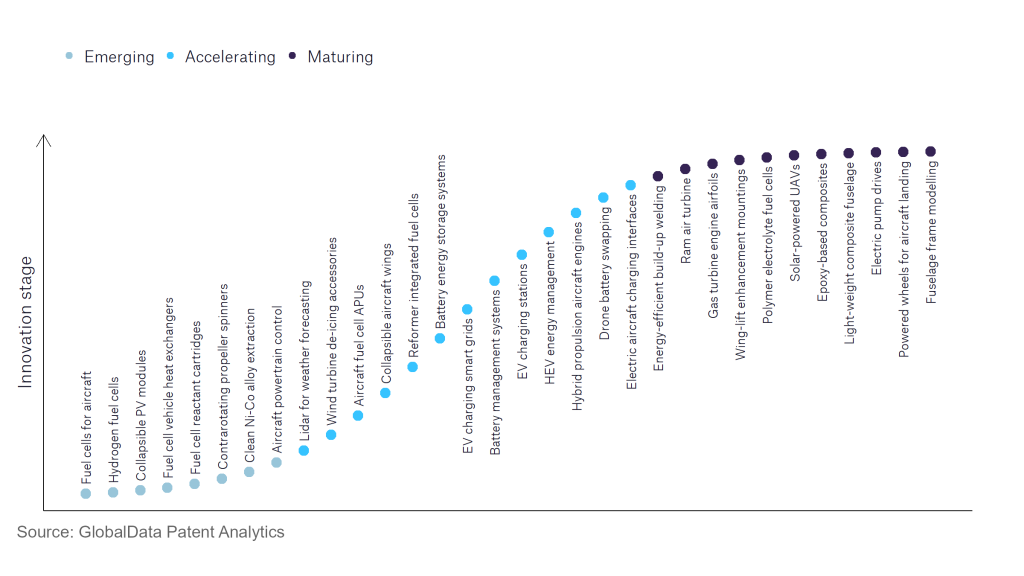The aerospace and defence industry continues to be a hotbed of innovation, with activity driven by the need to lower operational costs, larger consumer trends, and electrification, and growing importance of technologies such as hydrogen and electric aircraft and advanced materials. In the last three years alone, there have been over 174,000 patents filed and granted in the aerospace and defence industry, according to GlobalData’s report on Environment Sustainability in Aerospace, Defence & Security: Hybrid propulsion aircraft engines. Buy the report here.
However, not all innovations are equal and nor do they follow a constant upward trend. Instead, their evolution takes the form of an S-shaped curve that reflects their typical lifecycle from early emergence to accelerating adoption, before finally stabilising and reaching maturity.
Identifying where a particular innovation is on this journey, especially those that are in the emerging and accelerating stages, is essential for understanding their current level of adoption and the likely future trajectory and impact they will have.
180+ innovations will shape the aerospace and defence industry
According to GlobalData’s Technology Foresights, which plots the S-curve for the aerospace and defence industry using innovation intensity models built on over 262,000 patents, there are 180+ innovation areas that will shape the future of the industry.
Within the emerging innovation stage, hydrogen fuel cells, contrarotating propeller spinners, and fuel cells for aircraft are disruptive technologies that are in the early stages of application and should be tracked closely. EV charging stations, collapsible aircraft wings, and electric aircraft charging interfaces are some of the accelerating innovation areas, where adoption has been steadily increasing. Among maturing innovation areas are fuselage frame modelling and powered wheels for aircraft landing, which are now well established in the industry.
Innovation S-curve for environmental sustainability in the aerospace and defence industry

Hybrid propulsion aircraft engines is a key innovation area in environmental sustainability
A hybrid propulsion system combines a conventional combustion aircraft engine and an electric motor. Electric energy, stored in onboard batteries, is used to supplement thrust generated by conventional engines to grant greater fuel efficiency, range, and reduce emissions.
GlobalData’s analysis also uncovers the companies at the forefront of each innovation area and assesses the potential reach and impact of their patenting activity across different applications and geographies. According to GlobalData, there are 80+ companies, spanning technology vendors, established aerospace and defence companies, and up-and-coming start-ups engaged in the development and application of hybrid propulsion aircraft engines.
Key players in hybrid propulsion aircraft engines – a disruptive innovation in the aerospace and defence industry
‘Application diversity’ measures the number of different applications identified for each relevant patent and broadly splits companies into either ‘niche’ or ‘diversified’ innovators.
‘Geographic reach’ refers to the number of different countries each relevant patent is registered in and reflects the breadth of geographic application intended, ranging from ‘global’ to ‘local’.
Patent volumes related to hybrid propulsion aircraft engines
Source: GlobalData Patent Analytics
Safran is one of the leading patent filers for hybrid-propulsion aircraft engines. The company has stated that it intends to lead the way in decarbonising the aviation sector, and is targeting a 42.5% reduction in emissions per passenger kilometre by 2035 in comparison to 2018 levels. The company has developed the ENGINeUS Aircraft Electric Motor, which is a modular, scalable motor suitable for hybrid propulsion applications. Some other key patent filers include Rolls-Royce, Airbus, Raytheon Technologies, and Boeing. The intensity of involvement of major aircraft OEMs and engine manufacturers in the technology demonstrates its potential in a future aviation market shaped by environmental concerns.
In terms of application diversity, Karem Aircraft holds the most widely usable patents regarding hybrid-propulsion aircraft engines, whilst Boeing, Wisk Aero, and Textron followed behind. VoltAero held the top position in terms of geographical reach, trailed by Boeing, Leonardo, and Jetoptera.
Hybrid-propulsion aircraft engines are likely to become widely deployed as the aviation industry as a whole, driven by consumer and regulatory pressure, proceeds to a low-emission future. Whilst all-electric and hydrogen propulsion remain long-term goals, it is likely that hybrid propulsion will be an essential technology in the medium term as these novel propulsion methods are developed and introduced.
To further understand the key themes and technologies disrupting the aerospace and defence industry, access GlobalData’s latest thematic research report on Defence.
Data Insights
From

The gold standard of business intelligence.
Blending expert knowledge with cutting-edge technology, GlobalData’s unrivalled proprietary data will enable you to decode what’s happening in your market. You can make better informed decisions and gain a future-proof advantage over your competitors.



